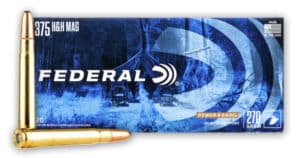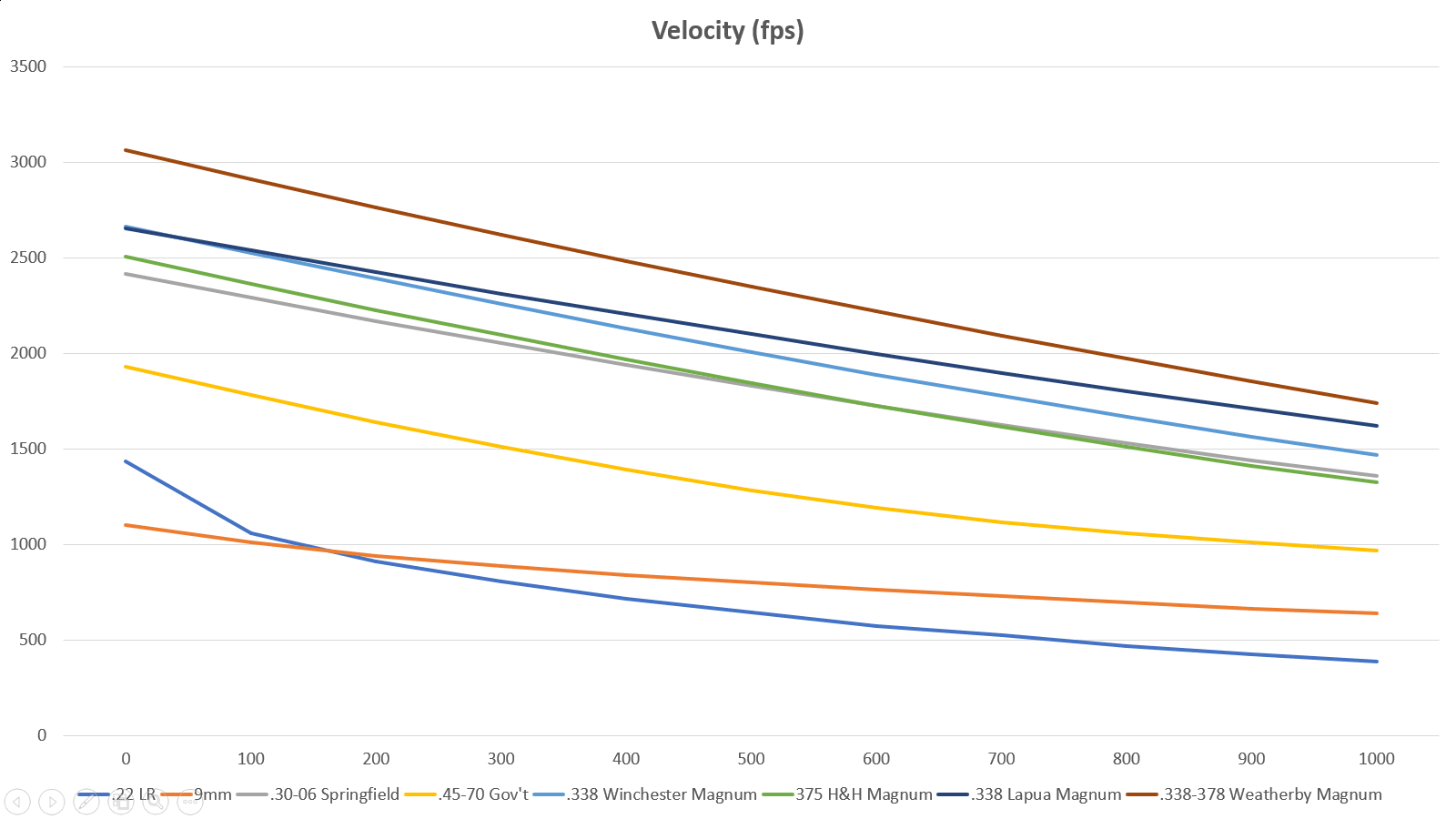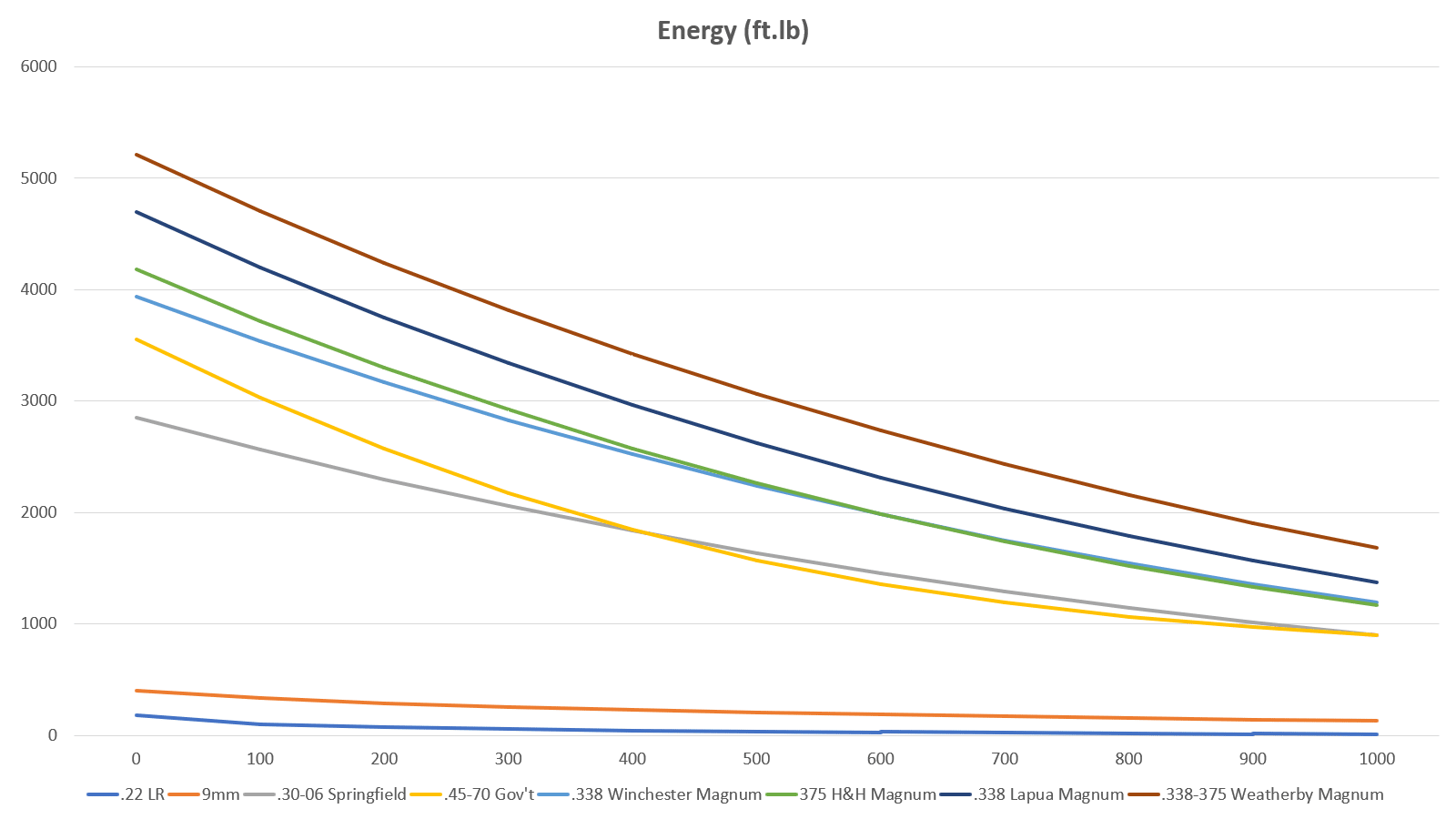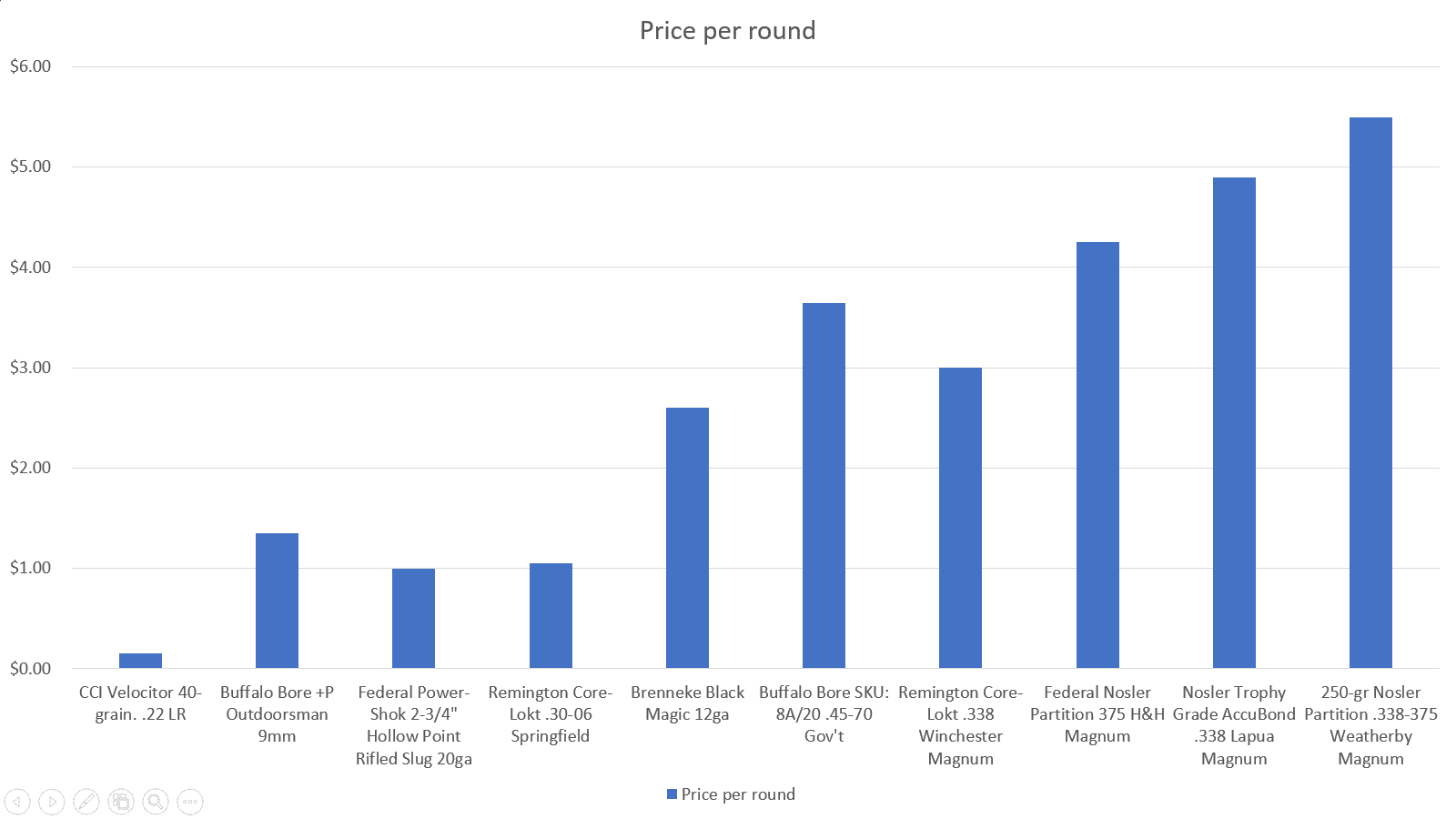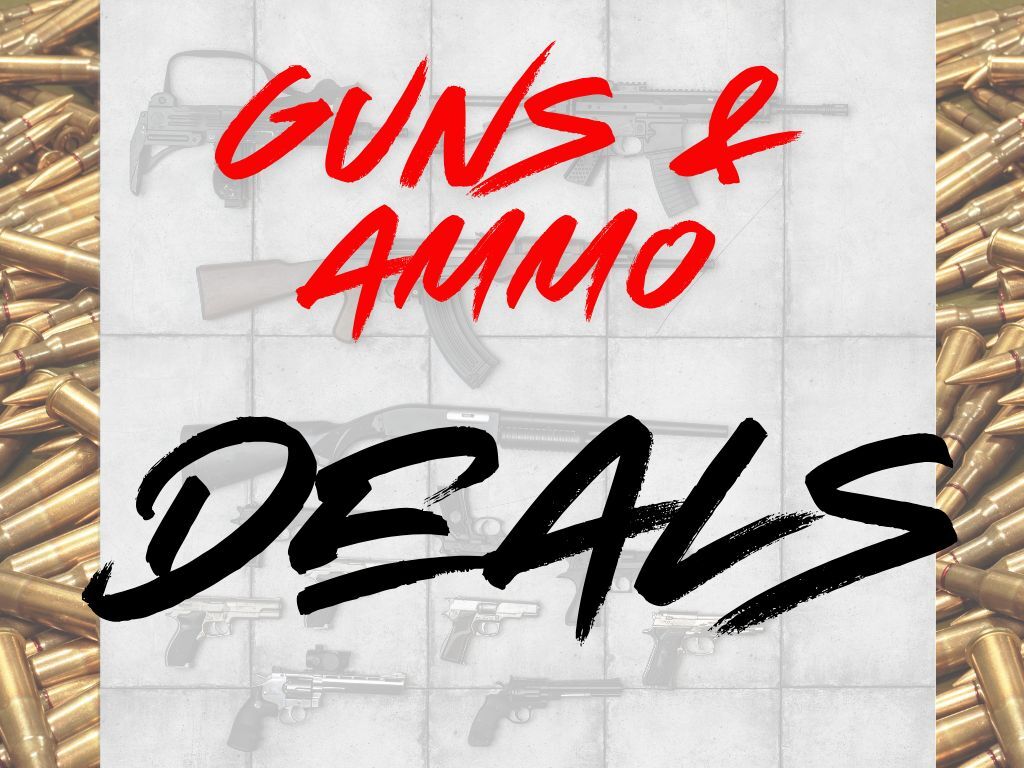Table Of Contents
Pundits are of the opinion that shot placement trumps the ballistic capabilities of any given caliber. And this supposedly applies to anything anyone shoots at, with very little exception. Common sense says there is merit to this argument. Certainly this is true when it comes to Calibers for Grizzly Bear Hunting.
Assuming deep enough penetration, a shot to the brain should immediately incapacitate any living thing on the planet. Or at least, that’s what this page from NIH.gov’s website says. And I don’t see any reason not to believe it.
But sometimes that curious side of us asks, if all that really counts is shot placement, then can the .22 LR be considered adequate for something like, say, a 700-pound grizzly bear? Or perhaps, a better way of asking the same question is, what’s the point of all the hunting calibers and loads on the market if the .22 LR could pretty much do what those were all designed to do?
THE BE-ALL AND END-ALL Grizzly Bear Caliber?
On the surface, the question sounds uninteresting — dig deeper, and it’s anything but. For one, there have been recorded cases of people successfully killing bear using bullets on the weakest end of the caliber pool, such as the lowly .22 Long (i.e. one of the two weaker parent cartridges of today’s .22 Long Rifle).
Grizzly Bear Killed With a .22
The earliest of such cases was recorded in 1953 when a lady of Native American descent in her 60’s killed a bear with an old Stevens bolt-action rifle. She reportedly dropped it with a single shot to the side of the head. It was still twitching so she had to put seven more rounds into its skull, but the point is she used a weak caliber and was able to make it work.
9MM Kills a Brown Bear
Fast forward to more recent times, if you’ve been checking out Buffalo Bore’s website, you probably might have seen a page where they offer a 147-grain hard cast lead flat nose 9mm +P load they call the Outdoorsman. This particular load was reportedly used by an Alaskan guide to successfully drop a huge aggressive brown bear.
Granted, standard pressure 9mm is already much more powerful than the .22 LR, and the particular overpressure load from Buffalo Bore’s page is no slouch — it’s only around a hundred feet per second slower than similar-weight .357 Magnum loads.
But it’s still generally considered weak — only really adequate for use against man-sized critters, definitely not designed for bear. And yet, that particular Buffalo Bore 9mm load worked!
Recommended Calibers and Brands for Grizzly Bear Hunting
Circling back to one of the earlier questions, what’s the point of all the hunting calibers on the market if the average (i.e. weak) everyday run-of-the-mill cartridges can do what they’re supposed to do?
We scoured the Internet for the most popular calibers for bear and their respective factory loads on the market to see what they have to offer, try to find out why each of them is much more preferable than the .22 LR or the 9mm.
And while we’re at it, we’ll try to determine how some are better than all the others in these key areas: ballistics, effective range, and ammo pricing.
20-Gauge for Bear Hunting?
First on our list is the 20-gauge which some consider too weak and inadequate for bear. After all, what’s the point in the 20-gauge anyway when there’s a bigger shotgun caliber that’s even more popular and more widely available, i.e. the 12-gauge? (Yes, some people say the recoil is lighter on the 20-gauge but semi-auto shotguns in 12-gauge do mitigate recoil too so there’s little merit to that argument).
But if you happen to already own a good shotgun chambered in 20-gauge and you want to hunt bear — and you have no interest in spending extra to get another shotgun chambered in its bigger caliber brother, don’t fret. Federal has you covered with their 2-¾-inch Power-Shok rifled slug.
Federal 20 Gauge Power Shok Rifled Slug
The Power-Shok uses a hollow point slug that weighs 3/4 oz., which is capable of sub-MOA accuracy at up to a hundred yards regardless of whether your shotgun’s barrel is smooth or rifled (but if you’re trying to hunt bear at distances of a hundred yards or more, you should really consider getting yourself a rifle — we’ll get to that in a bit).
Owing to its ~0.61-inch diameter and with a muzzle energy of around 1,800 foot-pounds, Federal’s Power-Shock 20ga slugs has more oomph than the powerful .454 Casull. It should be more than enough for any bear at distances not exceeding 50 yards.
The per-round price on these slugs isn’t bad either at just $1.90 a pop. As for the recommended launching platform, there are a couple of really affordable semi-auto shotguns with barrel lengths of 24 to 26 inches over at Guns.com. Just now they have a 20-GA Weatherby Element semi-auto selling for only $525.
.30-06 Springfield Caliber for Grizzly Bear Hunting
The .30-06 Springfield might be the weakest rifle cartridge on our list, but it’s common knowledge among big game hunting enthusiasts that this caliber packs a wallop and will take down any game animal in North America which includes, but isn’t limited to, black bear and grizzly, assuming that the shooter will do his part, i.e. taking well-aimed shots and buying the right ammo to begin with.
One of the best commercially available hunting loads for the .30-06 is Remington’s Core-Lokt that uses a 180-grain soft-point bullet. The copper jacket is locked to the lead core, ensuring perfectly controlled expansion that results in deeper penetration. As far as ballistic performance, this 220-grain bullet has enough energy to take down bear at distances of around 400 yards.
Remington’s Core-Lokt .30-06
And the best thing about this load is it won’t break the bank. At just $1.05 per round, the Remington Core-Lokt .30-06 is one of the most affordable .30-06 loads on the market today. Unsurprisingly, it also has the lowest per-round price out of all the rifle cartridges included in this write-up.
As for rifle pricing, typical ones chambered for the .30-06 Springfield cost anywhere from $1,000.00 all the way up to $2,500.00. The cheapest one at the time of this writing is on Guns.com for a jaw-dropping $595.99. It’s a Winchester XPR bolt-action with a 24-inch barrel and polymer stock with textured panels — in factory new condition.
12-Gauge for Grizzly Bear Hunting
The 12-gauge shotgun is probably the first firearm that will come to mind when you ask anyone what type of gun they’d prefer to use against bear — and for good reason. Even standard run-of-the-mill 00 buckshot has enough power to kill a bear.
But just because it can get the job done doesn’t mean we recommend it. Besides, shot placement is near impossible when using shot shells. This is why if you have a 12-gauge shotgun, you’d want to use slugs, of which there are two types: rifled slugs, and sabot slugs.
Rifled Slugs vs. Sabot Slugs
Some of you might ask, what’s the difference between the two, or when do you pick one over the other? The answer is pretty straightforward — rifled slugs are for shotguns with a non-rifled barrel (i.e. smooth bore), and sabot slugs are for shotguns with rifled barrels. In general, you can’t mix and match.
And I have a bone to pick with that proposition. Why limit your ammo choices to the type of barrel your shotgun has when there are certain brands of slugs that can be used for both? This is when Brenneke’s Black Magic Magnum slugs come in.
BRENNEKE BLACK MAGIC MAGNUM
Assuming your shotgun is chambered for 3-inch 12-gauge shells (and it most likely is but talk to the manufacturer if you’re unsure), a Black Magic Magnum slug is capable of producing over 3,000 foot-pounds of bear-killing energy at the muzzle. Even with its heavy weight and terrible sectional density, this slug still has energy to give the .454 Casull a run for its money at 100 yards.
Granted, it’s nowhere near as accurate as the .454 Casull but if you can compensate for the bullet drop, the Black Magic Magnum slug will kill bear out to a hundred yards. We’d recommend you try to take it from between 50 to 75 yards though, if you want better chances of placing your shots.
.45-70 Government – Calibers for Grizzly Bear Hunting
The .45-70 is everyone’s favorite as far as brush gun calibers because it packs a punch and doesn’t require a long barrel to get things done. It might not be your best bet when trying to take down large game at distances of over 400 yards, but it’s not too difficult to stalk bear when hunting in the woods.
What is a Brush Gun?
Now I know some of you may not have heard of a brush gun before, and so you might be inclined to ask, what is a brush gun? The short and boring answer is, it’s a lever-action rifle chambered in a big-bore rifle cartridge. Want to know what’s so special about it?
If you are going to stalk bear in the thick woods, nothing’s stopping you from bringing any type of rifle you might have, be it a bolt-action or a lever gun. But the latter is favored by many because of its typically shorter barrel which allows for easier maneuverability. Also, the lever on a lever-action is easier and faster to actuate than the bolt on a bolt-action rifle, allowing for faster follow-up shots in case of bear attack.
Lever Action for Bear Hunting
Because of these inherent advantages, a lever-action rifle in .45-70 is considered by many to be the quintessential brush gun. As a platform though, it isn’t without its downsides, which, for the sake of this article, we won’t be discussing at length here. But the long and short of it is, when hunting bear in the woods, nothing beats a brush gun in .45-70 — it is simply unequaled.
Lever-action rifles chambered in .45-70 are a dime a dozen so if you’re in the market for one, you might find it difficult to make a decision as far as which brand and model to purchase. We wholeheartedly recommend the Henry All-Weather. It’s known to be reliable, it holds up even in the toughest of weather conditions because of its finish, and it won’t break the bank. At the time of this writing, there is one listed on Guns.com selling for $1,359.99.
Henry All-Weather Lever Action
As for hunting ammo, I suggest you try some of Buffalo Bore’s 430 grainers with an advertised muzzle velocity of 1,925 feet per second. Doing the math, the bullet produces up to 3,556 foot-pounds of force at the muzzle.
Buffalo Bore 430 Grain
At a hundred yards, energy falls to about 3,028 foot-pounds of force which makes it more powerful than the .30-06 Springfield up to 400 yards. At $3.65 per round, it’s a little on the expensive side (this is one of the platform’s aforementioned downsides), but with its power and versatility (there are many single-action revolvers chambered for the .45-70), you’ll get your money’s worth.
.338 Winchester Magnum – Calibers for Grizzly Bear Hunting
On the subject of versatility, the consensus among hunting rifle caliber pundits is, the .338 Winchester Magnum has been one of the most versatile hunting cartridges since it was introduced in 1958. It’s essentially a .458 Winchester Magnum (which itself is a child cartridge of the 375 H&H, another hunting caliber listed just below), necked down to accept a .338-inch bullet.
With bullet weights for this caliber ranging from 200 grains on the lightweight end all the way up to 300 grains, the .338 WinMag will take down any game in the North American continent, which is its claim to fame as far as versatility. But if you’ll have trouble choosing the right ammo, we recommend that you try Remington’s 250-grain Core-Lokt.
Remington’s 250-grain Core-Lokt
The 250-grain Core-Lokt has an advertised velocity of 2,660 feet per second, generating energy at the muzzle of around 3,920 foot-pounds of force. At 500 yards, this particular bullet still has 2,237 foot-pounds of force, exceeding energy levels that the most powerful production handgun caliber in the world, the .500 S&W Magnum, can generate at the muzzle.
As far as recoil, the .338 WinMag is noted for its somewhat more manageable recoil when compared to its more powerful rivals’. That’s another thing experienced hunters praise this caliber for. But as with all things in life, the versatility and better recoil control come at a price.
Though not as expensive as ammo for the .45-70, .338 WinMag ammo typically don’t come cheap. Remington’s 250-grain Core-Lokt retails at $3.00 per round on Midway USA. I imagine it’ll be hard to find bargain basement deals on this ammo.
MOSSBERG PATRIOT .338 Winmag
Still, if you want to try the .338 WinMag as a hunting platform, you might be glad to know that rifles chambered for the .338 Winchester aren’t as expensive as ammo. They’re usually selling for around $600, and if you’re lucky, you might be able to find great deals on Guns.com. At the time of this writing, they have a Mossberg Patriot in walnut selling for less than $500. Now that’s a bargain!
375 H&H Magnum – Calibers for Grizzly Bear Hunting
I mentioned earlier that the 375 H&H Magnum is the .338 WinMag’s parent cartridge, but there’s more to it than that. A really old dinosaur of a hunting cartridge (it was born in England in 1912), the 375 H&H Magnum as a hunting caliber is as venerated as it is time-proven, with typical muzzle energies well within the range of 4,000 foot-pounds of force regardless of bullet weight.
https://www.youtube.com/watch?v=6i6wxEiqdD0
And even after being eclipsed by a number of other rifle calibers more than a hundred years after is inception, it’s still the most popular rifle caliber for hunting in the African Safari and the minimum required caliber for dangerous game, able to take down game species significantly larger than bear — among which are giraffe, elephant and hippopotamus.
With the myriad of ammo brands and bullet types on the market, if you’ll be on the fence on which to purchase for bear, we recommend that you try Federal’s 270-grain Power-Shok. For such a heavy bullet, the fact that it generates 4,163 foot-pounds of force at the muzzle means you’ll have enough firepower to take down even the largest of polar bears at well over 500 yards.
Federal’s 270-grain Power-Shok 375 H&H Magnum
But with that kind of power comes downsides, as anyone would expect. First off, if you’re of small to average stature and you don’t spend enough time in the range, the 375 H&H Magnum’s recoil (out of a typical rifle that weighs around nine pounds) would not just be difficult to control — it would be downright punishing.
Now I know there’s that one gentleman in the room who knows his way around these calibers — he would probably say you can always use a PAST recoil pad shield which makes this caliber’s kick a non-issue. I hear you loud and clear, sir. Those recoil pads aren’t too expensive, why not buy one indeed?
And that’s when the other downside comes in — price. Unlike the previously recommended caliber, the.338 WinMag, ammo and launching platform for the 375 H&H Magnum aren’t as wallet-friendly.
The Federal 300-grain Nosler Partition we recommend comes in at $4.25 per round, which makes it over 41% more expensive than the .338 WinMag — but it’s not really 41% more powerful or 41% more effective, is it?
As for rifles chambered for this caliber, assuming you’ll want one, they’re priced anywhere from $1,000 all the way up to $5,000. These include listings from 2A-friendly websites like Guns.com.
WINCHESTER 70 ALASKAN
And if you think those are already on the pricey side, you can’t be more inaccurate. I chanced upon a Blaeser R8 Jaeger that costs a little under $13,000 which looked ludicrous as far as rifle prices go, until I found a listing for an even more expensive museum-piece. It’s a Holland & Holland “ROYAL” model that costs an unreal $36,950.00!
.338 Lapua Magnum – Calibers for Grizzly Bear Hunting
We now go to our two recommended bear calibers for long range, i.e. distances of 1,000 yards or greater. If you’re into long range shooting, you are probably familiar with the .338 Lapua Magnum — probably even own a rifle chambered for that caliber and shoot it on a regular basis. But did you know that at 1,000 yards, the typical .338 Lapua Magnum has more energy than the typical .44 Magnum has at the muzzle?
Long Range Calibers for Grizzly Bear Hunting
Originally developed in the early 1980’s as an improved version of a wildcat sniper rifle caliber designed by the Armaments Research Company (ARC) for the military, the 338 Lapua Magnum started life as a slightly shortened and necked-down .416 Rigby. It was made in an attempt to fill an important niche between the two most popular military sniper rifle calibers of the time: the 7.62x51mm (.308 Winchester), and the .50 BMG.
The U.S. Navy saw the potential in the little cartridge and commissioned a well-known Finnish aerospace and defense company, Nammo Lapua Oy, to make refinements to the original design. The dimensions of the originally shortened and necked-down .416 Rigby case were kept the same but the web area was made thicker so it could handle pressures in the 70,000 psi range.
This improvement in case strength would allow the then newly designed B408 Lock Base bullet to retain supersonic velocities over distances of up to 1,300 yards, giving it a flatter trajectory while having more energy. By comparison, conventional 7.62x51mm ball ammo of the time would slow down to subsonic levels at around 770 yards.
Our ammo recommendation for this caliber goes to 338 Lapua Magnum Match Grade Ammo by Sellier & Bellot. As one would expect from any match-grade ammo brand, these don’t come cheap. With a per-round price of around $4.90, these Nosler 300-grains won’t be for everyone — but if you’re the type who likes to challenge the norm and you want to try and take out bear from around a thousand yards away, this particular load is about as good as it gets.
338 Lapua Magnum Match Grade Ammo by Sellier & Bellot
There aren’t too many who have succeeded in these types of long-range hunts because nobody cares about it. Experienced bear hunters prefer to be as close to the animal as possible, i.e. within 60 to 70 yards and up to a maximum of only 200 yards for a kill to be deemed ethical. If you’re looking to become one of the few who get to brag about successfully hunting bear from long range, there’s no better option than these 300-grain Nolsers.
SAVAGE 110 PRECISION
But wait, there’s more. You might be pleasantly surprised to know that even if ammo for this caliber isn’t cheap, there is a rifle model that screams budget-class price but performs just as good as its more expensive competitors: the Savage 110. At the time of this writing, there’s one selling on Guns.com for a little over $1,000. If you’re shopping for a rifle chambered for the .338 Lapua Magnum, you should look for similar offers.
.338-378 Weatherby Magnum – Calibers for Grizzly Bear Hunting
The .338-378 Weatherby Magnum started out as just another wildcat rifle round in the early 1960s. But a few decades after its inception, it would become one of the best 338-caliber ultra long-range shooting cartridges in the world, surpassing many other rifle calibers in its class as far as ballistics and popularity.
And it would prove itself to be one hell of an ultra-long range bear round too. Earlier we mentioned that the .338 Lapua Magnum has more energy at 1,000 yards than the .44 Magnum has at the muzzle. The .338 Weatherby Magnum slightly outperforms it by having more energy at 1,000 yards than the .454 Casull has at the muzzle.
Granted, the difference in energy levels between the .44 Magnum and .454 Casull isn’t huge, especially when you consider that today’s hottest .44 Magnum loads are only around 100-foot-pounds weaker than the hottest .454 Casull loads. But in some situations, that insignificant advantage could make the difference between a humane kill and a limping animal that will spend days bleeding its life away.
Our recommended brand of .338-378 Weatherby Magnum ammo is Weatherby’s very own Select Plus that uses a 225-grain Tipped Triple Shock. It has an advertised velocity of 3,060, generating a muzzle energy just shy of 5,200 foot-pounds of energy. At 1,000 yards, it still has over 1,700 foot-pounds, more than enough power for a quick humane kill assuming you hit your bear’s kill zone.
338-378 Weatherby Mag – 225 Grain TTSX – Weatherby Select
All that power doesn’t come cheap though, as I’m sure you already know. A 20-round box of Weatherby Select Plus costs $110.00 or $5.50 per round, making it the most expensive of all our bear hunt caliber recommendations. You will get your money’s worth as far as ballistic performance, and like the .338 Lapua Magnum, there are rifles chambered for this caliber that won’t break the bank.
WEATHERBY MARK V WEATHERMARK
At the time of this writing, there is a Weatherby Mark V Weathermark bolt-action rifle selling on Guns.com for around $1,500.00. Over at GunBroker you’ll find a similar bolt-action, the Weatherby Mark V AccuMark, selling for a similar price.
SO HOW DO THEY ALL COMPARE?
Let’s take a look at a few graphs to get a sense of how each of our recommended calibers and ammo brands compare to one another in the key areas we mentioned earlier. We are aware some of you may find this part boring — don’t worry, you can feel free to skip to the Top Picks portion of this article if you’re not into math.
Oh, and just so we can answer our question from the beginning of this article, we’ll also include ballistic figures and pricing info on the two weaker (but some people deem adequate) calibers mentioned earlier: the .22 LR and the 9mm.
Calibers for Grizzly Bear Hunting – VELOCITY
The first graph shows each of the cartridges’ velocity (in feet per second) from the muzzle and how much of a drop they all exhibit when reaching distances of up to 1,000 yards. Please take note that we’re not including velocity figures for the 20ga and 12ga because the consensus among responsible hunters is one should only hunt bear with a shotgun at distances not exceeding 100 yards.
As far as velocity, no other caliber on our recommendations list is quite as fast as the .338-378 Weatherby. And that shouldn’t come as a surprise to anyone — the 250-gr Nosler Partition we recommend has a muzzle velocity of over three thousand feet per second, which makes it more than twice as fast as CCI’s fastest .22LR load and almost three times faster than Buffalo Bore’s 9mm bear load.
Best Calibers for Grizzly Bear Hunting
But that doesn’t paint the whole picture, does it? As fast as it is, I don’t think the .338-378 Weatherby is the best bear caliber on our list. You see that gray line on the graph? It’s what Remington’s Core-Lokt .30-06 Springfield’s bullet velocity drop looks like — and it seems to be hanging out just fine with all the big boys up top.
ENERGY
Looking at the Energy graph above, it’s kind of the same boring story. The big winners, as you probably already guessed, are Nosler’s Trophy Grade AccuBond .338 Lapua Magnum and Weatherby’s 250-gr Nosler Partition .338-378 load. They’re the most expensive of the bunch so it shouldn’t be a surprise that they outperform all other cartridges on the list.
Energy of Calibers for Grizzly Bear Hunting
But what really makes this graph interesting is the four calibers in the middle. Buffalo Bore’s 8A/20 .45-70 Gov’t (yellow line) seems to overtake Remington’s Core-Lokt .30-06 Springfield (gray line) as far as bullet energy within 300 yards. But the former loses velocity fast when it reaches 400 yards. At 500 yards, the two calibers’ energy levels are about even.
Similarly, Federal’s Nosler Partition 375 H&H Magnum (green line) may have slightly more energy than Remington’s Core-Lokt .338 Winchester Magnum (sky blue line) within 300 yards, but at distances of 400 yards their energies start to even out, having virtually the same ballistic performance at up to 1,000 yards.
PRICE for Calibers for Grizzly Bear Hunting
And finally, we come to pricing. If you’re among the 0.001% of firearms enthusiasts, i.e. the type who can afford any caliber and brand of ammo they want without having to worry about next month’s home mortgage and car loan payments, you can feel free to skip this section and just buy the most expensive you can find anywhere.
But if you’re like 99.999% of us and ammo price can be a cause of concern to you most times, then you’re probably going to want the best bang-for-buck caliber and ammo brand when hunting bear. For most people, there’s the matter of having enough practice bullets to shoot before going out on a hunt.
Rifle Cost is a Factor
There’s also the firearm to consider for those who don’t have one already. If you have budget constraints or if your wife just counts every single dollar you make on pay days, the rifle you buy, depending on what caliber it’s chambered for, will also affect just how many rounds you can purchase for practice and for the actual hunt.
The short answer is, there might not be a best bang-for-buck caliber/ammo brand. The long answer is, there might be one, but it would depend on how far away from the bear you want to be when you pull that trigger. So which of our recommended caliber/ammo brands do we consider the best?
OUR BEST GRIZZLY BEAR HUNTING CALIBERS PICKS
If you’re among the fearless of us and you have no problems hunting bear within 50 yards (or you simply want the cheapest but still adequate shooting platform for bear defense), go with the 20-gauge. Federal’s Power-Shok 2-3/4″ 328-grain 20ga slugs only cost $1.00 a piece and will get the job done just as good as any other caliber on the market at close range.
If you’re hunting bear from over 50 yards and all the way up to 400 yards thereabouts, Remington’s Core-Lokt 30-06 Springfield isn’t that much more expensive than our 20-gauge recommendation at just $1.05 per round. It rivals the .45-70 Gov’t in performance but doesn’t cost anywhere near as much.
Assuming you want something that has more power than the 30-06 Springfield (maybe you’re hunting a bigger-than-average grizzly from between 400 to 600 yards), Remington’s 250-grain Core-Lokt .338 Winchester Magnum is only slightly less powerful than Federal’s 300-grain Nosler Partition 375 H&H Magnum but costs around 30% less.
Lastly, if you’re hunting any big game animal at distances of over 600 yards (possibly up to 1,000 yards too), you’ll want something that has more power than the .338 Winchester Magnum.
Between the .338 Lapua Magnum and .338-378 Weatherby, we’d recommend the latter. Weatherby’s 250-gr Nosler Partition .338-378 is the most expensive of all brands on this list at $5.50 per round, but when shooting long range you’ll need all the bullet energy you can get.
Calibers for Grizzly Bear Hunting – Conclusion
The good shot placement argument is, for the most part, impossible to refute. You want to incapacitate a bad grizzly bear? Therefore, you need to hit him within his center of mass. You want to hunt bear (or any game animal, for that matter)? You need to hit it within its kill zone. That’s just how things work.
But there’s more to shot placement than just hitting your target within its kill zone. At the very least, the bullet has to have enough energy to penetrate vital organs and cause tissue damage for that well-aimed shot to count. The .22 Long, though proven capable sixty-seven years ago, will not have enough energy for a humane kill when hunting bear from a hundred yards away.
When hunting any type of game animal, you’ll want the right cartridge for the job. It is for this reason there are many different hunting calibers on the market, with varying velocity and energy levels and thus, varying effective range. Choosing one for hunting bear might not be easy as there are more than a few things to consider, but we still get to choose. And with choice, there is power.












